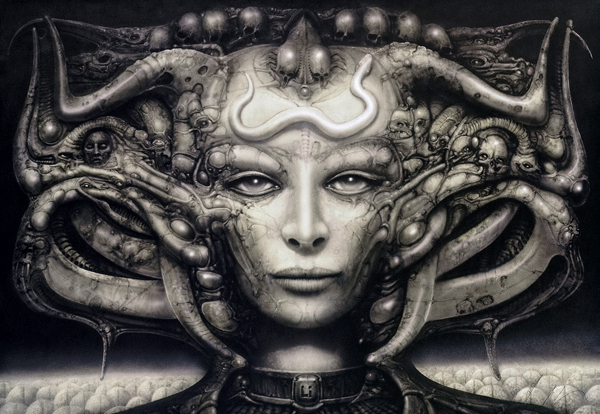Movie review by Greg Carlson
Belinda Sallin’s documentary “Dark Star: H.R. Giger’s World” captures the Swiss artist near the end of his interesting life. Giger, who rocketed to international fame and Oscar glory for the iconic designs he contributed to Ridley Scott’s “Alien,” died in 2014 at the age of 74. Sallin, given full access to her subject, capitalizes on the privilege to prowl through the cluttered rooms of Giger’s home, a shabby heap teeming with macabre curiosities and enough specialized volumes to rival the finest libraries. The dwelling immediately emerges as a central character in its own right, competing directly with Giger’s artwork as the movie’s primary visual attraction.
The filmmaker is less successful communicating any substantive analysis of Giger’s imagery, content to let a handful of associates repeat simple explanations of Giger’s thematic concerns familiar to anyone with even the most cursory knowledge of the man’s eroticized “biomechanical” hybridizations of the organic and the industrial. An affable, quiet Giger, operating with the full awareness that his post-stroke physical health has slowed him considerably, doesn’t say much. Sallin supplements several scenes with archival footage of Giger from his most active years, chasing the man’s quicksilver talent for locating the intersection between dream and nightmare.
While Sallin includes some of Giger’s most famous images, few meaningful stories accompany them. For example, a tantalizing reference by Giger’s mother in law to the use of “Penis Landscape/Work 219: Landscape XX” by the Dead Kennedys as a poster insert in “Frankenchrist” reads only as a confusing throwaway. While the American obscenity trial involving Jello Biafra and Alternative Tentacles should open the door to an essential chapter in the Giger biography, Sallin ignores it and all the other historical collaborations and/or relationships between Giger and recording artists like Debbie Harry and ELP.
As expected, Sallin covers the “Alien” experience, but opts for period interviews – including a brief clip of Scott acknowledging Giger’s gifts – rather than any newly collected content. Prior to that section of the film, a short episode on Li Tobler, the actor who would become Giger’s life partner, model and artistic muse, leaves viewers hungry for a deeper examination of arguably the most important single figure in Giger’s career. Giger, choked with emotion, confirms that speaking about Tobler (who committed suicide in 1975) is still difficult decades later. The two appeared together in Fredi Murer’s 1972 television documentary “Passagen,” and it is not difficult to imagine their alliance as the subject of an entire feature.
Sallin’s cameras follow Giger to a few public appearances, observing a number of moments in which the most devoted members of the Giger cult tremble and break down in the presence of their deity. “Dark Star” misses yet another opportunity to place its subject into proper perspective, largely skipping over the fan/artist relationship. At least Celtic Frost’s Tom Gabriel Fischer, one admirer who creatively channeled his dedication to Giger’s vision, attests to the peculiar levels of hero worship offered to Giger. Fischer, who parlayed his fandom into a stint as one of Giger’s professional assistants, enjoys a rare and unusual connection few disciples know. Interest in Giger is not likely to wane, and “Dark Star” is not going to be the last word on the spellbinding surrealist.
